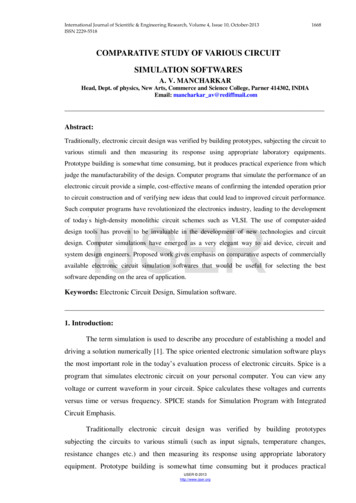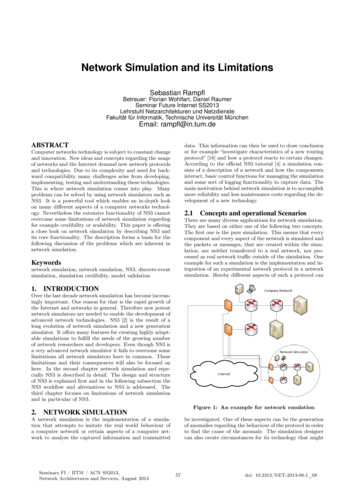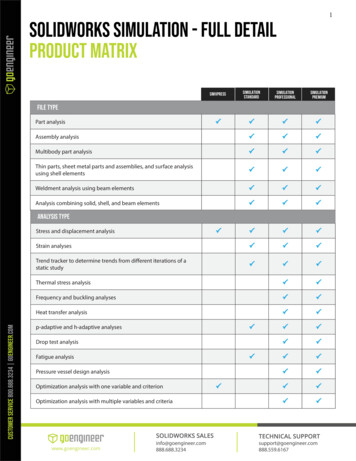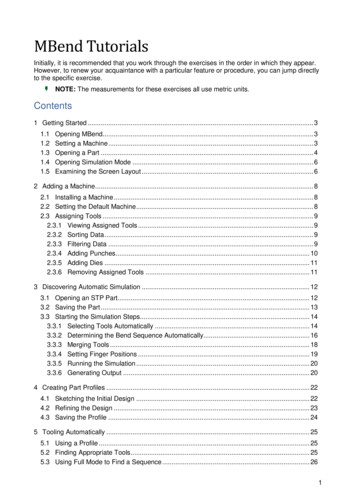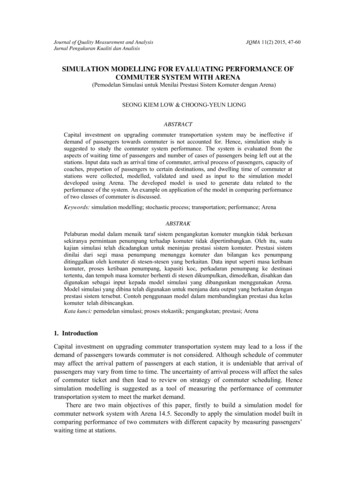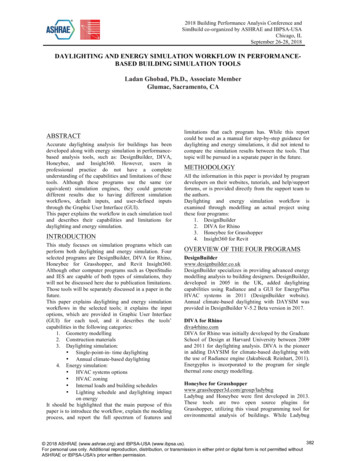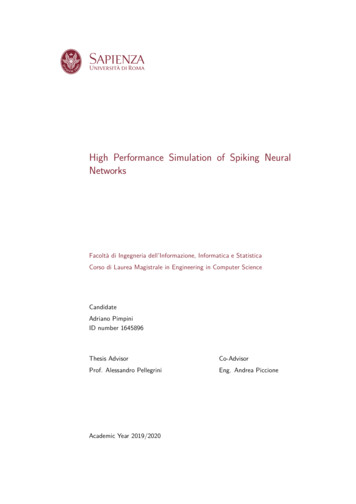
Transcription
High Performance Simulation of Spiking NeuralNetworksFacoltà di Ingegneria dell’Informazione, Informatica e StatisticaCorso di Laurea Magistrale in Engineering in Computer ScienceCandidateAdriano PimpiniID number 1645896Thesis AdvisorCo-AdvisorProf. Alessandro PellegriniEng. Andrea PiccioneAcademic Year 2019/2020
Thesis defended on 22 October 2020in front of a Board of Examiners composed by:Prof.Prof.Prof.Prof.Prof.Prof.Prof.Tiziana Catarci (chairman)Francesca CuomoFrancesco Delli PriscoliStefano LeonardiAndrea MarrellaAlessandro PellegriniSimone ScardapaneHigh Performance Simulation of Spiking Neural NetworksMaster’s thesis. Sapienza – University of Rome 2020 Adriano Pimpini. All rights reservedThis thesis has been typeset by LATEX and the Sapthesis class.Author’s email: adriano.pimpini@gmail.com
iiAbstractSpiking Neural Networks (SNNs) are a class of Artificial Neural Networks that closelymimic biological neural networks. They are particularly interesting for the scientificcommunity because of their potential to advance research in a number of fields, bothbecause of better insights on neural behaviour, benefitting medicine, neuroscience,psychology, and because of the potential in Artificial Intelligence. Their ability torun on a very low energy budget once implemented in hardware makes them evenmore appealing. However, because of their behaviour that evolves with time, when ahardware implementation is not available, their output cannot simply be computedwith a one-shot function—however large—, but rather they need to be simulated.Simulating Spiking Neural Networks is extremely costly, mainly due to theirsheer size. Current simulation methods have trouble scaling up on more powerfulsystems because of their use of conservative global synchronization methods. Inthis work, Parallel Discrete Event Simulation (PDES) with Time Warp is proposedas a highly scalable solution to simulate Spiking Neural Networks, thanks to theoptimistic approach to synchronization.The main problem of PDES is the complexity of implementing a model on it,especially of a system that is continuous in time, as time in PDES “jumps” fromone event to the next. This greatly increases friction towards adoption of PDES tosimulate SNNs. As such, current simulation-based work on SNNs is relegated toworse-scaling approaches. In order to foster the adoption of PDES and further thework on simulation of SNNs on larger scales, in this work a solution is developedand presented that hides the underlying complexity of PDES.Chapter OrganizationIn Chapter 1, the research problem addressed in the thesis is introduced andmotivations are adduced. In Chapter 2 Artificial and Spiking Neural Networksare introduced, along with other important aspects, in order to frame the researchcontext. In Chapter 3 Parallel Discrete Event simulation, which is the technique onwhich this work builds the approach, is introduced. In Chapter 4 some well-known
iiiand widespread simulators specialized in Spiking Neural Networks are introduced,to give an idea of what the state of the art is.In Chapter 5 the problem of simulating large spiking neural networks is introducedand the developed solution is presented in depth, explaining all the actions taken tomake PDES transparent to the user.In Chapter 6 the methods and results of the experimental assessment are presented. In Chapter 7 conclusions are drawn and some directions are suggested forfuture improvements regarding this work and the research context in general.
ivContents1 Introduction12 Spiking Neural Networks42.1Neural Networks at a Glance . . . . . . . . . . . . . . . . . . . . . .72.2Spiking Neural Networks . . . . . . . . . . . . . . . . . . . . . . . . .92.3The Leaky Integrate and Fire Spiking Neuron . . . . . . . . . . . . .163 Parallel Discrete Event Simulation3.13.219Discrete Event Simulation . . . . . . . . . . . . . . . . . . . . . . . .193.1.1Systemic Approach to DES . . . . . . . . . . . . . . . . . . .203.1.2Components of DES . . . . . . . . . . . . . . . . . . . . . . .213.1.3DES Kernel logic . . . . . . . . . . . . . . . . . . . . . . . . .24Parallel Discrete Event Simulation . . . . . . . . . . . . . . . . . . .253.2.1The Synchronization Problem . . . . . . . . . . . . . . . . . .283.2.2Optimistic Synchronization . . . . . . . . . . . . . . . . . . .293.2.3Additional Supports for Simulation. . . . . . . . . . . . . . .344 Related Work364.1Brian. . . . . . . . . . . . . . . . . . . . . . . . . . . . . . . . . . .364.2Neuron . . . . . . . . . . . . . . . . . . . . . . . . . . . . . . . . . . .384.3NEST . . . . . . . . . . . . . . . . . . . . . . . . . . . . . . . . . . .405 Simulating Large Spiking Neural Networks5.142The module . . . . . . . . . . . . . . . . . . . . . . . . . . . . . . . .445.1.144Interfaces . . . . . . . . . . . . . . . . . . . . . . . . . . . . .
Contentsv5.1.2Data structures . . . . . . . . . . . . . . . . . . . . . . . . . .485.1.3The simulation flow . . . . . . . . . . . . . . . . . . . . . . .506 Experimental Assessment6.152The neuron implementation . . . . . . . . . . . . . . . . . . . . . . .526.1.1Leaky Integrate and Fire . . . . . . . . . . . . . . . . . . . .526.1.2Poisson neurons. . . . . . . . . . . . . . . . . . . . . . . . .58The networks . . . . . . . . . . . . . . . . . . . . . . . . . . . . . . .586.2.1Potjans and Diesmann’s Local Cortical Microcircuit . . . . .596.2.2Other networks . . . . . . . . . . . . . . . . . . . . . . . . . .626.3Correctness . . . . . . . . . . . . . . . . . . . . . . . . . . . . . . . .636.4Performance . . . . . . . . . . . . . . . . . . . . . . . . . . . . . . . .666.27 Conclusions70A CPU and Memory Footprint72Bibliography77
1Chapter 1IntroductionFrom the beginning of the history of human thought, we have wondered aboutconsciousness: what sets us and other animals apart from a plant? How arewe able to reason and have thoughts? Replicating intelligence has always been oneof humanity’s aspirations, whether it be to study it, to employ it to solve problems,or simply for the sake of playing god.Thanks to modern research and knowledge, we know that the brain is the organthat controls the functions of the body and interprets the information from theoutside world, allowing us to think and much more. Thus, the most obvious pathtowards replicating (or rather, emulating) intelligence that is currently being exploredis that of replicating the brain’s inner workings, or at least its behaviour. In recentyears, the concept of Artificial Neural Networks (ANNs) has become a hot topic incomputer and data science and artificial intelligence, mainly owing to the work ofcompanies such as Google and OpenAI, that succesfully employed ANNs to performa plethora of tasks with excellent results, from speech recognition, to beating theGo world champion in 2017 ([16], [18], [17]), and beating a team of pro-playersof the online multiplayer PC game Dota 2 [11]. Needless to say, the last two aremind-blowing achievements that could have easily earned their place in sciencefiction novels as recently as 20 years ago.The Artificial Neural Networks that are the de-facto standard of the industryare however just inspired at a very high level by the way the brain works, and donot really take into account what actually happens inside of it: billions of cells—the
2neurons—receive input stimuli in the form of electric pulses, charge themselves up,and when they are “charged enough”, they produce an electric impulse themselves,which gets propagated to the other neurons that are connected to them (more onthis in Chapter 2). In these ANNs neurons compute a mathematical function in aone-shot fashion every time an input is received, usually with no regard for timewhatsoever.Spiking Neural Networks (SNNs) are a class of ANN that aims to emulate thebiological behaviour of the brain. As such, they need to simulate the behaviour ofthe neuron, synapses, and any other interesting object in real-time. This leads to ahigher fidelity execution of the neural network, at the price of higher computationalcosts. SNNs however show an interesting trait: since the neurons react to andcommunicate through electrical stimuli, they can be modelled as circuits, andspecialized hardware can be implemented that runs SNNs with extremely highperformances both in terms of speed and energy consumption. SNNs have beenshown to be capable of carrying out tasks that other ANNs do too with comparableaccuracy, while boasting an extreme degree of efficiency. Hardware however presentsa problem related to building costs: designing and manufacturing a chip is nocheap task, and is not sustainable for prototyping. Neuromorphic chips—such asIBM’s TrueNorth [2]—exist, but present limitations related to their design, whichconstrains experimentation. The applications of SNNs are not limited to AI however,as simulating biologically-accurate networks can be of vital importance for variousfields of research, such as Neurology, Neuroscience, and Medicine in general, to namea few. This is why simulation of SNNs is fundamental for the near and the distantfuture alike. The aim of this work is to make simulation of SNNs viable on HighPerformance Computing systems.Current simulation supports for SNNs consist of time-stepped simulators, whichcarry out the simulation by computing the state of all objects at every smallincrement of time. These simulators have acceptable performance on single-threadand even multi-thread environments, but lack the ability to scale beyond fewcomputational nodes because of the conservative synchronization methods theyemploy. Furthermore, updating the state of every object at each timestamp means
3updating objects that are doing nothing, too, introducing costs that could be avoided.Parallel Discrete Event Simulation (PDES) [6] with Time Warp (or optimistic PDES)[8] is the simulation method we adopt in this work to make execution on HPC systemspossible and worthwhile.In optimistic PDES, timestamped events are used to mark the passage of time,jumping from one event to the next. When an event is handled by an object, it cangenerate new events (messages) directed towards other objects in the simulation.The simulation is carried out in parallel on different threads and even nodes, thatoptimistically schedule events they have locally, assuming no causality violations willhappen because of it. If a violation happens, execution is rolled back to a consistentstate and resumed. This optimistic synchronization method allows for an extremedegree of parallelism, without having to waste time waiting for synchronization tohappen.The problem with PDES is that current simulators require the user to be familiarwith the concept of PDES and sending messages, and managing the object execution.As such, writing a model for PDES is a complex endeavor requiring a high degree ofknowledge and familiarity with the approach. This makes developing for PDES verycostly, discouraging potential adopters. This holds true for the field of computationalneuroscience, too. As such, a simulator that simplifies the adoption of PDES isneeded.To encourage adoption of PDES, in this work a module was developed which,attached to a PDES simulator tailor-made to support Spiking Neural Networkssimulation, simplifies the adoption of PDES for simulating Spiking Neural Networks.This is achieved by hiding the complexity behind a series of Application ProgrammingInterfaces that hold the modeller’s hand through successful creation and executionof the model. The underlying simulator is multi-threaded and can run on multi-nodesystems, making execution on HPC systems possible.
4Chapter 2Spiking Neural NetworksThe unresting research on Neural Networks as computational systems is thebyproduct of the desire to understand and mimic the brain’s ability to learn, generalize, and carry out extremely complex tasks. Paired with the incredible efficiency thatbiological brains have, it is no wonder that the most obvious and sought-after pathto achieve such capabilities is that of copying the brain in a number of its aspects,and eventually covering all of them in due detail, when the technology will allowit. Various approaches have been developed, each with its strengths and drawbacks,and each with a different degree of similarity with the original biological structure,with SNNs reaching for a higher degree of fidelity.The brain is a complex system, composed of a huge number of simple functionalunits: neurons. A neuron (see Figure 2.1) consists of a cell body called soma,dendrites, and an axon. The axon and dendrites are filaments extruding from thesoma which usually is, instead, compact. While the axon sparsely branches and canextend for surprising lengths (up to one meter in humans), dendrites do not travelfar from the soma, but produce abundant branching. We can see the dendrites as theinput channels of the neuron, while the axon is used for the output: at the tip of theaxon’s branches are axon terminals, where the neuron transmits signals across thesynapses to another neuron’s dendrite. In Neural Networks which strive for a higherdegree of similarity, attention is currently placed on modelling of synapses and theirweights, while dendrites are ignored and the axon’s presence is abstracted, but itsrole can still be recognized in topological aspects, such as the neuron’s eagerness to
5connect to neurons that are geographically closer, and the spike transmission delay,which depends both on the type of synapse and the point of the axon body at whichthe synapse lies.Figure 2.1. Representation of a neuron.Source: “Neural Networks with R”Neurons have plasma membranes with embedded voltage-gated ion channels. Themembrane—among other things—electrically separates the inside of the cell withthe outside, effectively creating what can be seen as a capacitor; the ion channelsare sensitive to changes in the membrane electric potential, which influences theiropening and closing: the higher the potential is, the more these channels open,allowing more ions to flow through the otherwise ion-impermeable membrane. Whenthe membrane potential is close to the resting potential these channels are completelyclosed, however when the potential rises they open up, until it hits a precise thresholdvoltage for which a great number of (sodium) ions is allowed to flow inside the cell,starting an explosive chain reaction further raising the cell’s membrane potential,causing more channels to open, and so on. The rapid rise of potential causes aninversion of the plasma membrane polarity, which rapidly deactivates the sodiumion channels, trapping the sodium (Na ) ions inside the cell. The inversion of themembrane polarity is called action potential [3] (or signal, or spike) and propagatesalong the body of the cell, specifically along the axon, to ultimately reach thesynapses and propagate to the post-synaptic neurons. Note that the depolarizationis temporary as the polarity inversion opens potassium (K- ) ion channels, which
6in turn let potassium ions flow outside of the membrane, returning the membranepotential to a negative value over a short period of time.Figure 2.2. A visualization of the action potential propagating through the axon BrainHoney/Resource/6716/digital first content/trunk/test/hillis2e/hillis2e ch34 2.htmlNow the cell, that usually has potassium ions inside and sodium ions outside,is back to negative potential, but with potassium ions outside and sodium ionsinside the membrane. This situation is reverted by the sodium potassium pumpwhich actively transports sodium back out and potassium back inside of the plasmamembrane. Until this process is completed the membrane potential cannot rise,as such the time interval between the generation of the action potential and thecompletion of the “on resetting” process is called refractory period of the neuron.These concepts have been introduced as they will be useful in talking about spikingneurons.In this chapter, Spiking Neural Networks (SNNs) are presented. We begin byintroducing the concept of Neural Network (NN), and then go on to take a lookat different kinds of NNs and some of their application cases. Lastly we introduceSNNs and go over how they work, their advantages, the challenges that using thempresents and how they are currently dealt with, and how they are currently beingused to achieve what.
2.1 Neural Networks at a Glance2.17Neural Networks at a GlanceArtificial Neural Networks (ANNs). ANNs are networks (or circuits) composed of artificial neurons (or nodes). Artificial Intelligence is the field in which ANNshave become so popular thanks to their ability to learn and approximate complexunknown functions. In the simplest kind of ANN for AI—the first generation [10]—,neurons are perceptrons [14]. Perceptrons employ an extremely simple algorithm:every neuron has a vector w of weights, one for each incoming connection, and abias b. When the input vector x is received, the neuron computes the output f (x)based on the value of the following (linear) activation function:f (x) 1if w · x b 0, 0otherwise(2.1)The perceptron is a linear binary classifier: a single unit—once trained—canbe used to decide whether an input belongs to a class, given that it is linearlyseparable from the others. A network of perceptrons consisting of three or morelayers (one input layer, at least one hidden layer, one output layer) can be built,giving birth to a feed forward ANN commonly referred to as Multilayer Perceptron(MLP). Perceptrons constituting this network usually have a non-linear activationfunction: networks with this kind of perceptron are seen as the second generation ofANN [10]. The combination of multiple layers and non-linearity in activation allowsMLPs to distinguish data that is not linearly separable.Convolutional Neural Networks (CNNs). CNNs are the class of ANNs thatfostered the impressive advancements in Machine Learning and AI we have witnessedin recent years. Because of the way convolution works, they are particularly wellsuited for images, but the fields of application vary widely. The main differences withMLP lie in the way information is processed, and in the fashion in which neuronsare connected. Indeed, MLP suffers from the fact that adjacent layers are usuallyfully connected, which means a great deal of computation has to be carried out toproduce an output, and a fair amount of memory is used to keep track of the weights.CNNs instead are constituted of convolutional blocks. A convolutional block is
2.1 Neural Networks at a Glance8made of three layers: convolution, pooling, and activation. The first layer performsconvolution, which actually is a sliding dot product of the layer’s kernel with theinput feature maps. Kernels are matrices of weights, which are tuned when trainingthe network. The fact that kernels are layer-specific, as opposed to neuron-specificweights in MLPs, means that there is a much lower number of weights, letting CNNshave a smaller memory footprint. Next is the pooling layer, which is responsiblefor reducing the spatial size of the representation, so as to reduce the amount ofparameters needed and computation done in the network. This is done on everyfeature map separately, by aggregating different adjacent elements into one. Anexample is max-pooling: a subset of the feature map is taken and substituted bya single element, the value of which is the max among those of the initial values.Finally, the activation layer, which takes a feature map as its input and outputs afeature map called activation map computed by means of an activation functionthat is applied element-wise. The repetition of these three processes is the core ofCNNs as we know them, and allows CNNs to learn to extract and recognize specificfeatures in the input.In both the above classes of neural networks, when a neuron receives an input itcomputes a rather simple function and always yields an output that is instantaneouslypropagated forward. The computation moves going from the back of the network tothe front in a one-shot fashion.Recurrent Neural Networks (RNNs). RNNs are a class of ANNs in whichnodes are organized in successive layers, but differently from the first two classeswe have mentioned, the output of every node is directed not only towards the nextlayer, but also recurs by going back towards the neuron that generated it—or someother memory unit—so as to be used in the subsequent timestep. This structureallows them to have a memory of what happened in the past, enabling them toexhibit temporal dynamic behaviour. RNNs are used in prediction tasks, thanksto their ability to analyze time series. Furthermore, they can work on sequencesof arbitrary length (contrary to CNNs which require input of predefined length),which makes them prime candidates for text recognition and speech-to-text tasks:
2.2 Spiking Neural Networks9input is fragmented into an ordered number of vectors of the appropriate size, andthe vectors are fed to the network, one per timestep (or frame). To mention somenoteworthy use cases, RNNs are part of what is behind Google’s currently unmatchedspeech-to-text engine, as well as the text-to-speech one.Similarly to what happens in CNNs, RNNs have a parameter sharing mechanism:while in CNNs weights are shared at layer level and get reused while convolutingover the input feature maps, in RNNs the weights are shared among time steps, thusdecreasing the memory footprint, as well as the time needed to train the network.2.2Spiking Neural NetworksSpiking Neural Networks (SNNs) are a class of ANNs that mimics natural neuralnetworks more closely. This is achieved through the usage of spiking neurons, whichcommunicate by sending signals (spikes) to each other through synapses. Spikingneurons are stateful, and the synapses connecting them can be too. Differentlyfrom what happens in other classes of ANNs, where neurons produce and propagatean output whenever they receive an input, spiking neurons only fire when a specificcondition is met. Specifically, much like biological neurons, they fire when theirmembrane potential reaches a specific threshold value. When a spiking neuronfires, it generates a spike that is propagated to the neurons it is connected to, whichreact by increasing or decreasing their membrane potential accordingly, over time.Before reaching other neurons however, the spike passes through synapses, which areweighted and also introduce a transmission delay. Indeed, a fundamental aspectthat differentiates SNNs from other ANNs is the role that time plays: while in theaforementioned classes of ANNs the computation and propagation of the output isinstantaneous, spiking neurons need to wait for their membrane charge over time,then when threshold value is reached they fire, and after a transmission delay, onlythen do the post-synaptic neurons receive the signal. As such, information is notonly encoded in the way synaptic weights change the amplitude of spikes, but intheir timing as well. It is worth emphasizing how, while it may look similar incertain aspects, SNNs’ time dependence is different from that of RNNs: SNNs evolvethrough time and keep a memory of the not-so-short past (how long this memory
2.2 Spiking Neural Networks10goes back depends on the physical parameters of the neuron) in their state, whileRNNs do so by feeding their output back to themselves—which in SNNs cannothappen—or to other memory units—which are not present in SNNs—to use in thenext timestep.But what, specifically, is a spiking neuron, how is it stateful, and how is biological accuracy achieved? Spiking neurons models are derived from experimentalobservation of natural neurons’ behaviour. Starting from the emergent behaviour ofthe neuron, electronic circuits that approximate it are devised. The structure andparameters of the circuits are derived by feeding the neuron with different inputcurrents and seeing what the response to the various different stimuli is. We knowthat neurons’ plasma membrane’s isolating properties give rise to a capacitance(membrane capacitance Cm ), and that the potential between the two sides of themembrane (that we refer to as membrane potential Vm ) is what kick-starts the actionpotential propagation once it reaches a target threshold value Vth . Furthermore weknow that in absence of stimuli the membrane potential resets to a resting value Vr ;this also holds true after the action potential is generated (which we also refer to asfiring, or spiking) and the sodium potassium pump is done reverting the neuron backto its resting state, that is, after the refractory period τref is elapsed. Additionally,we know that for the membrane potential to rise, there has to be some kind inputcurrent I, which is the sum of the stimuli coming from pre-synaptic neurons, andthat an external current Iext can be supplied (e.g. for experimental observation).This series of observations already gives some clues about what to look for whencreating a biological neuron model. Furthermore, the presence of the capacitancealone makes it obvious that a spiking neuron is stateful (the minimum state beingjust the membrane potential at a given time) and such state evolves with time.This gives a hint on a fundamental aspect that will be discussed later on, aroundwhich the entire work presented in this document revolves: to be run on computers,networks of spiking neurons have to be simulated through time. This means thatrunning a SNN on a computer is a costly endeavour.
2.2 Spiking Neural Networks11Why Spiking Neural Networks? If running a SNN is so much more computationally expensive than other ANNs, why should we direct our attention towardsthem?The first reason is obvious and possibly already satisfactory on its own: wewant to eventually be able to efficiently and precisely simulate a human brain—orparts of it—to be able to study in detail its behaviour in various experiments, or tounderstand how modifications in the structure or physical aspects of its componentswould impact it; neurological research would gain a powerful tool to test and validatehypotheses; medicine would be helped in diagnosing and treating brain diseases.The second reason is that because spiking neurons are modelled as electroniccircuits they can easily be implemented in hardware. A series of neuromorphic chipshave already been created and commercialized (see IBM’s TrueNorth neuromorphicprocessor [2]). This removes the cost associated with simulation, and a series ofadvantages arise with respect to all other ANNs: No approximation: since the electronic components are physically present,there is no approximation stemming from the precision limit that is inherentof computer simulations. Computation is inherently and naturally parallel: what actually happens in achip with physically implemented neurons is essentially signal processing. Noorchestration or communication between worker threads (which then may ormay not share memory, etc.) is needed. Locally stored state: state is stored in the components, which means nomoving data back-and-forth from memory to CPU and vice-versa, which is acrippling bottleneck when running networks on machines using Von-Neumannarchitecture. Energy and power efficiency: specialized circuitry is vastly more energy andpower efficient than general purpose computational units, whether it be CPUsor GPUs we compare it with.Sadly, such huge advantages come at a cost, more specifically, hardware manufacturing cost. This is also because SNNs are huge: they require a great number
2.2 Spiking Neural Networks12of neurons, and an even greater number of synapses. Before investing in hardware,it is vital to conduct appropriate research. One may want to compare firing ratesand general network behaviour with those of the actual natural neural network theyare trying to replicate, or any other correctness metric of interest. This is especiallyimportant when no access to a neuromorphic chip is given, or when implementinga new kind of neuron or synapse that existing neuromorphic chips might not beable to properly replicate. This is where simulation of SNNs comes into play: itis needed to prototype new hardware solutions while staying within a reasonablecost and time frame, and to validate new approaches when hardware solutions areeither not available or physically cannot do so. Furthermore, if between now and therelease of neuromorphic chips to consumer market (and their widespread adoptionas hardware accelerators) a point is reached in which SNN simulation becomes veryefficient, we will be able to exploit SNNs to perform some tasks without having ahardware implementation or accelerator.Simulation. Now that we have established that simulation of SNNs is somethingthat we cannot forgo—not for the short future at least—the time has come to delvedeeper into this fascinating world.Firstly, some words have to be spent on what a simulation is. Simulating aphysical system on a computer entails building a mathematical model that describesthe dynamic behaviour of said system and approximates it to a satisfactory degree; theevolution through time of such model is then computed (i.e. the model is simulated)with the help of some simulation software, which allows to gain various insightsabout the real-life system’s behaviour under a plethora of different assumptions.Simulation is used when running experiments in real life is unfeasible either becauseof monetary cost (one might not want to destroy hundreds of airplanes for the sakeof seeing what would happen by crashing at different angles), time constraints (evenif one had the funds to crash hundreds of airplanes, they would not have the time toproduce them), safety reasons (even with the right funds and time, crashing planesremains risky), or straight impossibility (good luck with crashing a plane. on Mars).Furthermore, simulating lets
High Performance Simulation of Spiking Neural Networks Facoltà di Ingegneria dell'Informazione, Informatica e Statistica Corso di Laurea Magistrale in Engineering in Computer Science





